
The Constitution of 3 May 1791, titled the Government Act, was a written constitution for the Polish–Lithuanian Commonwealth adopted by the Great Sejm that met between 1788 and 1792. The Commonwealth was a dual monarchy comprising the Crown of the Kingdom of Poland and the Grand Duchy of Lithuania; the new constitution was intended to address political issues following a period of political agitation and gradual reform that began with the Convocation Sejm of 1764 and the election that year of Stanisław August Poniatowski, the Commonwealth's last king. It is the third written constitution in history, after that of the United States and San Marino.

A konfederacja was an ad hoc association formed by Polish–Lithuanian szlachta (nobility), clergy, cities, or military forces in the Polish–Lithuanian Commonwealth for the attainment of stated aims. A konfederacja often took the form of an armed rebellion aimed at redressing perceived abuses or trespasses of some authority. Such "confederations" acted in lieu of state authority or to force their demands upon that authority. They could be seen as a primary expression of direct democracy and right of revolution in the Commonwealth, and as a way for the nobles to act on their grievances and against the state's central authority.

Prince Adam Kazimierz Czartoryski was an influential Polish aristocrat, writer, literary and theater critic, linguist, traveller and statesman. He was a great patron of arts and a candidate for the Polish crown. He was educated in England and after his return to Poland in 1758, he became a member of the Sejm (parliament), Crown General of Podolia and Marshal of General Confederation of Kingdom of Poland.

The Great Sejm, also known as the Four-Year Sejm was a Sejm (parliament) of the Polish–Lithuanian Commonwealth that was held in Warsaw between 1788 and 1792. Its principal aim became to restore sovereignty to, and reform, the Commonwealth politically and economically.
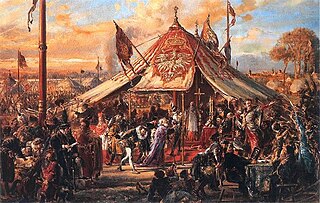
Royal elections in Poland were the elections of individual kings, rather than dynasties, to the Polish throne. Based on traditions dating to the very beginning of the Polish statehood, strengthened during the Piast and Jagiellon dynasties, they reached their final form in the Polish–Lithuanian Commonwealth period between 1572 and 1791. The "free election" was abolished by the Constitution of 3 May 1791, which established a constitutional-parliamentary monarchy.

Mikołaj Ostroróg (1593–1651) was a Polish–Lithuanian szlachcic (nobleman), politician and general.
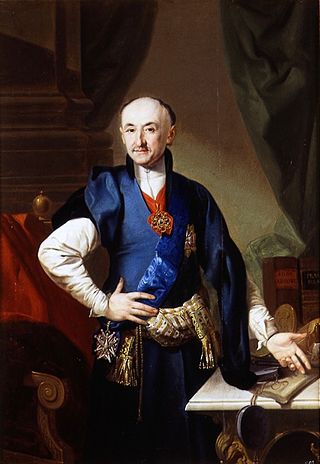
Jacek Małachowski, of the Nałęcz coat-of-arms (1737–1821) was a Polish nobleman, politician and administrator as well as Polish chancellor.

Prince Kazimierz Nestor Sapieha (1757–1798) was a Polish-Lithuanian noble (szlachcic) and one of the creators of the 3 May Constitution.
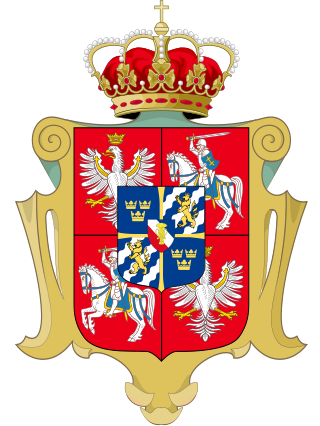
The General Sejm was the bicameral legislature of the Polish–Lithuanian Commonwealth. It was established by the Union of Lublin in 1569 following the merger of the legislatures of the two states, the Sejm of the Kingdom of Poland and the Seimas of the Grand Duchy of Lithuania. It was one of the primary elements of the democratic governance in the Commonwealth. The sejm was a powerful political institution that the king could not pass laws without its the approval.

Józef Ankwicz, of Awdaniec coat of arms, also known as Józef z Posławic and Józef Awdaniec, was a politician and noble (szlachcic) in the Polish–Lithuanian Commonwealth. He held the office of castellan of Nowy Sącz from 1782. Deputy to the Great Sejm, and most infamously, the Grodno Sejm: for his actions during the latter he is remembered as one of the most prominent collaborators with the foreign partitioners of Poland.
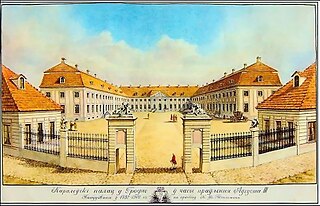
Grodno Sejm was the last Sejm of the Polish–Lithuanian Commonwealth. The Grodno Sejm, held in autumn 1793 in Grodno, Grand Duchy of Lithuania is infamous because its deputies, bribed or coerced by the Russian Empire, passed the act of Second Partition of Poland. The Sejm started on 17 June and ended on 23 November 1793. It ratified the division of the country in a futile attempt to prevent its subsequent complete annexation two years later in the 1795 Third Partition of Poland.
The Cardinal Laws were a quasi-constitution enacted in Warsaw, Polish–Lithuanian Commonwealth, by the Repnin Sejm of 1767–68. Enshrining most of the conservative laws responsible for the inefficient functioning of the Commonwealth, and passed under foreign duress, they have been seen rather negatively by historians.
Franciszek Ksawery Chomiński was a Polish soldier, politician, translator and poet. Sejm deputy, deputy to the Lithuanian Tribunal and voivode of Mscislaw from 1788 in the Polish–Lithuanian Commonwealth, and marshal of the Grodno Governorate in the Russian Empire after partitions of Poland.
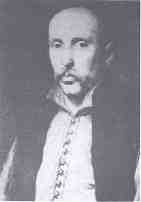
Stanislaw Krasiński was a Polish-Lithuanian nobleman (szlachcic) and politician.

Sejm of the Duchy of Warsaw was the parliament of the Duchy of Warsaw. It was created in 1807 by Napoleon, who granted a new constitution to the recently created Duchy. It had limited competences, including having no legislative initiative. It met three times: for regular sessions in 1809 and 1811, and for an extraordinary session in 1812. In the history of Polish parliament, it succeeded the Sejm of the Polish-Lithuanian Commonwealth and was followed by the Sejm of the Congress Poland.
The Sejm of the Grand Duchy of Posen was the parliament in the 19th century Grand Duchy of Posen and the Province of Posen, seated in Poznań/Posen. It existed from 1823 to 1918. In the history of the Polish parliament, it succeeded the general sejm and local sejmik on part of the territories of the Prussian partition. Originally retaining a Polish character, it acquired a more German character in the second half of the 19th century.
The Sejm of the Estates or Estates of Galicia were the parliament in the first half of the 19th century Galicia region in Austrian Empire. The body existed from 1775 to 1845. In the history of the Polish parliament, it succeeded the general sejm and local sejmiks on the territories of the Austrian partition. The Estates were disbanded following the Kraków Uprising of 1846. In 1861 they were succeeded by the Sejm of the Land.
The Legislative Sejm of the Second Polish Republic was the first national parliament (Sejm) of the newly independent Second Polish Republic. It was elected in the 1919 Polish legislative election.
Guardians of the Laws or Guard of Laws was a short-lived supreme executive governing body of the Polish–Lithuanian Commonwealth established by the Constitution of May 3, 1791. It was abolished, together with other reforms of the Constitution, after the Polish defeat in the summer of Polish–Russian War of 1792.
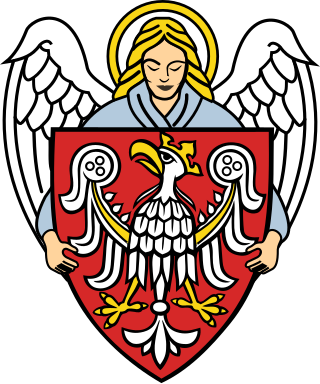
The General Sejm was the parliament of the Kingdom of Poland. It had evolved from the earlier institution of Curia Regis and was one of the primary elements of democratic governance in the Polish dominion.


















